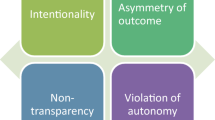Abstract
Online experiments are growing in popularity, and the increasing sophistication of Web technology has made it possible to run complex behavioral experiments online using only a Web browser. Unlike with offline laboratory experiments, however, few tools exist to aid in the development of browser-based experiments. This makes the process of creating an experiment slow and challenging, particularly for researchers who lack a Web development background. This article introduces jsPsych, a JavaScript library for the development of Web-based experiments. jsPsych formalizes a way of describing experiments that is much simpler than writing the entire experiment from scratch. jsPsych then executes these descriptions automatically, handling the flow from one task to another. The jsPsych library is open-source and designed to be expanded by the research community. The project is available online at www.jspsych.org.

Similar content being viewed by others
References
Buhrmester, M., Kwang, T., & Gosling, S. D. (2011). Amazon’s Mechanical Turk: A new source of inexpensive, yet high-quality, data? Perspectives on Psychological Science, 6, 3–5. doi:10.1177/1745691610393980
Crump, M. J. C., McDonnell, J. V., & Gureckis, T. M. (2013). Evaluating Amazon’s Mechanical Turk as a tool for experimental behavioral research. PloS ONE, 8, e51382. doi:10.1371/journal.pone.0057410
Eriksen, B., & Eriksen, C. (1974). Effects of noise letters upon the identification of a target letter in a nonsearch task. Perception & Psychophysics, 16, 143–149. doi:10.3758/BF03203267
Fox, E. (1995). Negative priming from ignored distractors in visual selection: A review. Psychonomic Bulletin & Review, 2, 129–139. doi:10.3758/BF03210958
Goldstone, R., Rogosky, B., Pevtzow, R., & Blair, M. (2005). Perceptual and semantic reorganization during category learning. In H. Cohen & C. Lefebvre (Eds.), Handbook of categorization in cognitive science (pp. 651–678). Amsterdam: Elsevier.
Goodman, J. K., Cryder, C. E., & Cheema, A. (2013). Data collection in a flat world: The strengths and weaknesses of Mechanical Turk samples. Journal of Behavioral Decision Making, 26, 213–224. doi:10.1002/bdm.1753
Kopp, B., Mattler, U., & Rist, F. (1994). Selective attention and response competition in schizophrenic patients. Psychiatry Research, 53, 129–139.
Mason, W., & Suri, S. (2012). Conducting behavioral research on Amazon’s Mechanical Turk. Behavior Research Methods, 44, 1–23. doi:10.3758/s13428-011-0124-6
McDonnell, J. V., Martin, J. B., Markant, D. B., Coenen, A., Rich, A. S., & Gureckis, T. M. (2012). psiTurk (Version 1.02) [Software]. New York, NY: New York University. Available from https://github.com/NYUCCL/psiTurk
Palmer, S. E. (1977). Hierarchical structure in perceptual representation. Cognitive Psychology, 9, 441–474. doi:10.1016/0010-0285(77)90016-0
Paolacci, G., Chandler, J., & Ipeirotis, P. G. (2010). Running experiments on Amazon Mechanical Turk. Judment and Decision Making, 5, 411–419.
Reips, U.-D., & Neuhaus, C. (2002). WEXTOR: A Web-based tool for generating and visualizing experimental designs and procedures. Behavior Research Methods, Instruments, & Computers, 34, 234–240. doi:10.3758/BF03195449
Ross, J., Irani, L., Silberman, M. S., Zaldivar, A., & Tomlinson, B. (2010). Who are the turkers? Worker demographics in Amazon Mechanical Turk. In CHI ’10: CHI Conference on Human Factors in Computing Systems (pp. 2863–2872). New York: ACM.
Zwaan, R. A., & Pecher, D. (2012). Revisiting mental simulation in language comprehension: six replication attempts. PloS ONE, 7, e51382. doi:10.1371/journal.pone.0051382
Author note
This material is based on work that was supported by a National Science Foundation Graduate Research Fellowship under Grant No. DGE-1342962. The author thanks Rob Goldstone, Nicholas de Leeuw, Rick Hullinger, and Peter Todd for feedback and suggestions on an earlier draft of this article, as well as the numerous people who have used jsPsych throughout the development process and have provided valuable feedback.
Author information
Authors and Affiliations
Corresponding author
Rights and permissions
About this article
Cite this article
de Leeuw, J.R. jsPsych: A JavaScript library for creating behavioral experiments in a Web browser. Behav Res 47, 1–12 (2015). https://doi.org/10.3758/s13428-014-0458-y
Published:
Issue Date:
DOI: https://doi.org/10.3758/s13428-014-0458-y




